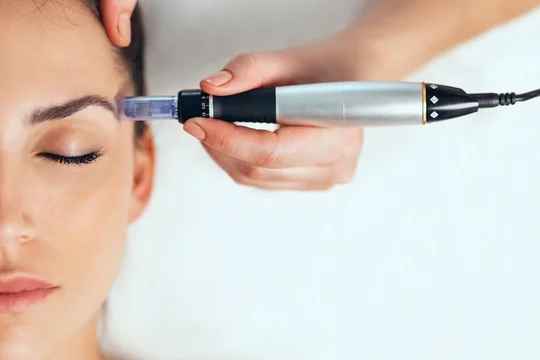Does RF microneedling really work safely on all skin tones, or is this just marketing hype? radio frequency microneedling combines two technologies – microneedling’s controlled micro-injuries with radiofrequency energy delivered beneath the skin surface. The insulated needles penetrate to depths of 0.5mm to 3.5mm, releasing thermal energy at the needle tips while protecting the epidermis. This dual mechanism stimulates collagen remodeling in the dermis while minimizing surface damage, making it suitable for various skin types.
Traditional laser resurfacing carries higher risks for darker skin tones due to epidermal heating that can trigger post-inflammatory hyperpigmentation. RF microneedling bypasses this limitation by delivering energy directly to deeper tissue layers. The treatment addresses acne scars, enlarged pores, skin laxity, and textural irregularities across diverse skin types when proper protocols are followed.
How RF Microneedling Differs from Traditional Treatments
RF microneedling needles create microscopic channels while simultaneously delivering radiofrequency energy at predetermined depths. Needle configurations typically range from 25 to 49 gold-plated tips per handpiece, allowing precise energy distribution. Depths are adjusted according to concerns:
- 1.5–2.0mm for acne scars
- 2.5–3.5mm for skin tightening
- 0.5–1.0mm for superficial texture improvement
The RF energy generates controlled thermal zones at 60–70°C, triggering immediate collagen contraction and long-term neocollagenesis. Fractional energy delivery accelerates healing while minimizing epidermal damage, reducing downtime compared to ablative lasers.
Skin Type Considerations and Safety Protocols
Fitzpatrick Types I–III
- Lighter skin tones tolerate standard settings with minimal risk of pigmentation changes.
- Typical starting depth: 2.0–2.5mm at 35–40 watts.
- Treatments every 4–6 weeks; post-treatment erythema resolves within 24–36 hours.
Fitzpatrick Types IV–VI
- Darker skin requires modified protocols to prevent post-inflammatory hyperpigmentation (PIH).
- Pre-treatment preparation: 4–6 weeks of tyrosinase inhibitors (kojic acid or tranexamic acid).
- Conservative settings: 1.5mm depth, 25–30 watts.
- Cooling protocols and extended treatment intervals (6–8 weeks) reduce melanin activation.
Treatment Areas and Applications
Facial Rejuvenation
- 0.5–1.0mm: periorbital skin
- 1.5–2.0mm: cheeks
- 2.0–2.5mm: lower face and neck
Body Applications
- Striae (stretch marks) treated at 3.0–3.5mm depth for collagen remodeling.
- Surgical scars: start 6–8 weeks post-healing, adjusted per scar type.
Pre-Treatment Requirements
- Screen for contraindications: active infections, isotretinoin use, pregnancy, cardiac pacemakers, metal implants.
- Cessation of retinoids 2–4 weeks prior.
- Topical anesthetic applied 45–60 minutes before treatment.
- Baseline photography to track progress.
Post-Treatment Recovery
24–48 Hours: erythema and warmth, gentle cleansing, occlusive moisturizers, avoid heat and exercise.
Days 3–7: micro-peeling and bronzing; gradual skincare reintroduction.
Weeks 2–4: visible texture improvements; collagen remodeling continues over months.
Managing Potential Complications
- Prolonged redness: topical corticosteroids under professional guidance.
- Temporary hyperpigmentation: especially in darker skin types, responds to tyrosinase inhibitors and sun protection.
- Acne flares: treat selectively; systemic antibiotics only if needed.
💡 Did You Know?
RF microneedling can be safely performed year-round with proper sun protection, unlike many laser treatments.
What an Aesthetic Doctor Says
Customization is key: adjusting needle depth, energy, and pulse duration ensures safe treatment for all skin types. Conservative initial settings for darker skin reduce PIH risk. RF microneedling can target multiple concerns simultaneously — acne, scarring, tightening, and texture. Post-treatment compliance significantly improves outcomes.
Putting This Into Practice
- Schedule treatments when 2–3 days of social downtime are feasible.
- Document responses to guide parameter adjustments.
- Prepare post-treatment supplies: gentle cleanser, barrier moisturizer, mineral sunscreen.
- Plan sessions during low sun exposure periods.
- Track improvements using consistent close-up photography.
When to Seek Professional Help
- Active cystic acne needing medical management
- History of keloid or hypertrophic scarring
- Skin conditions like eczema or rosacea in treatment areas
- Recent facial surgery or injectable treatments
- Unclear pigmentation issues
- Photosensitizing medications or immunosuppressants
- Recurrent cold sores needing prophylaxis
Common Questions
How does RF microneedling compare to fractional CO2 laser?
- RF microneedling: minimal downtime, suitable for all skin types, more sessions needed.
- Fractional CO2: faster resurfacing, longer recovery, higher pigmentation risk in darker skin.
Can it be combined with other treatments?
Yes, including neurotoxins, dermal fillers, LED therapy, and growth factor serums, with appropriate intervals.
Why do different facial areas respond differently?
Skin thickness varies; thicker areas tolerate deeper penetration and show more improvement.
How many treatments are needed?
Depends on severity, age, and healing capacity — 3 sessions for mild texture, 6+ for deep scars.
Next Steps
RF microneedling is a versatile, safe treatment for acne scars, skin laxity, and textural issues when protocols are tailored to individual skin types. MOH-accredited aesthetic doctors can assess your skin and design a treatment plan for optimal outcomes.

Isreal olabanji a dental assistant and public health professionals and has years of experience in assisting the dentist with all sorts of dental issues.
We regularly post timely and trustworthy medical information and news on Fitness, Dental care, Recipes, Child health, obstetrics, and more.


